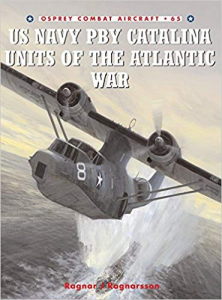224th Review US Navy PBY Catalina Units of The Atlantic War
The Consolidated Aircraft Corporation’s PBY Catalina is a perfect example of the demands that evolving technologies make on corporations, and the creative and engineering process. It is also an example of how quickly the twentieth century went from being the birth of aviation to the jet and aerospace age.
The designation PBY is the US Navy’s “Patrol Bomber” and “Y” their code for the Consolidated Aircraft Corporation of Buffalo, New York. Consolidated Aircraft existed from 1923 to 1996.
Before the advent of the aircraft carrier, during the fledgling days of aviation, the PBY concept – the flying boat – made perfect sense. These amphibious aircrafts were practical, rugged and could maneuver into places where land-based airplanes could not. The concept of creating airplanes that could operate from water was instrumental in alleviating the role and demands made on land-based airplanes. Another significant factor about flying boats was that during the first decades of flight, suitable runways were scarce.
Ragnar J. Ragnarsson’s US Navy PBY Catalina Units is a detailed account of the important role that the Catalina played in the Atlantic theatre, in addition to other parts of the world during WWII. Consolidated’s Catalina is the culmination of several of the company’s flying boats. The aircraft was the only long-range patrol-bomber at the start of WWII. The airplane’s role as a patrol aircraft meant that it would patrol along coastlines, protect allied ships from attack by sea and air, and perhaps most importantly, seek and destroy German submarines.
The Catalina and its crews earned a reputation for being rugged and dependable. The aircraft could fly for extended missions like few airplanes at the time could. The idea for the flying boat is as unique a form of technological marvel of the twentieth century as any aircraft that has been created. With easy access to the world’s oceans, seas, lakes and other waterways, the flying boat concept was utilized in a vast number of ways, including well-appointed passenger transport, as is the case with Pam American Airways clipper ships.
US Navy PBY Catalina Units of the Atlantic War is a superb publication that sets the record of this marvelous, original and practical aircraft for future generations to reap. The flying boat concept is a logical example of an excellent way to conduct search and rescue operations, a role that today has largely been assigned to the helicopter.
Ragnarsson offers good quality photographs of the many crews and airplanes that made up the diverse units that flew the PBY Catalina during WWII. With the growth of the aircraft carrier, the role of flying boats began to shrivel, until eventually; they were taken out of service. This is truly a shame, because even today, a strong case can be made for the practicality of flying boats, including for passenger service.
The history and service of the PBY Catalina can be appreciated by younger readers today and in the future because of fantastic publications like Osprey Publishing’s US Navy PBY Catalina Units of the Atlantic War. This series of books brings to light the astounding engineering ability and beauty of man’s inspired creations. Aviation enthusiasts come to these books to replenish their admiration for th












Leave a Reply